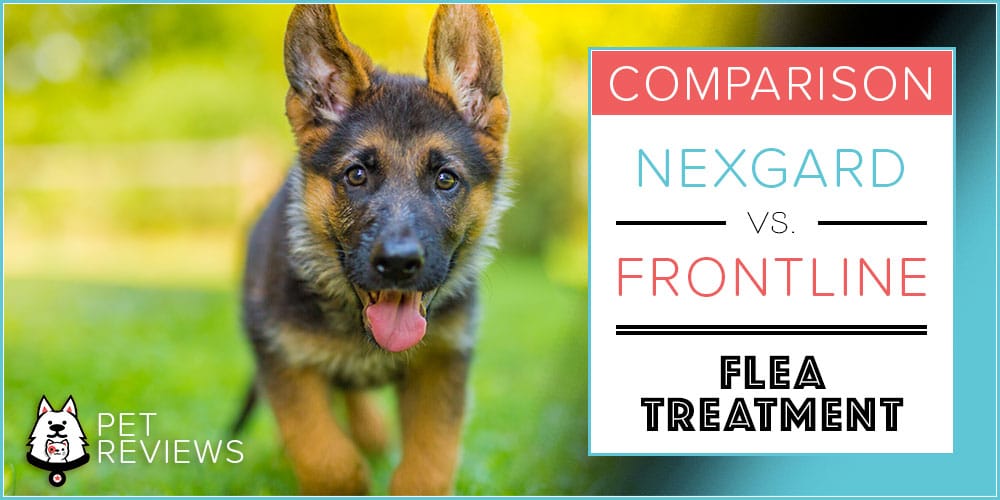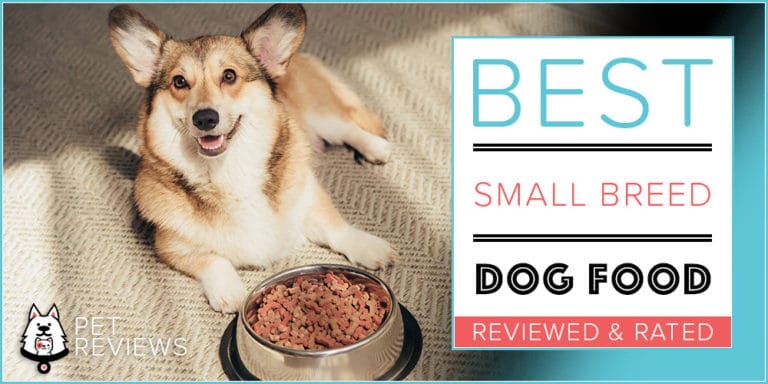NexGard vs. Frontline: 2024 Comparison and Key Differences
Quick Guide
Flea treatments are essential in protecting your pet from not only fleas but other pests, too. Insects like ticks, mosquitoes, biting flies, and lice can all be prevented with the right pest prevention product. They come in many different forms, as well, which helps when you are searching for the right one for your pet’s specific needs.
Oral chews, topical solutions, and collars are the most popular flea treatment options. Within each category, a variety of products are available that differ from each other in the ingredients used, the length of time the product remains effective, and many other factors.
Researching the various treatments on the market helps you find the safest and most effective product that will suit your pup’s individual needs and preferences. Keep reading for specific considerations to think about when choosing a flea treatment.
What to Look for in a Good Flea Treatment
No matter the particular flea treatment you decide to use, effective products will share certain attributes. Most important among these characteristics is the ability to kill and repel multiple pests.
Of course, the product should work well to kill fleas, but a truly exceptional flea treatment will cover other bothersome pests, too. Ticks, for example, are parasites that can transmit Lyme disease, a potentially serious illness. Ticks are found in almost every state in the U.S., especially in wooded areas, so using a product that kills them is crucial to your dog’s health.
Other pests covered by various flea products are mosquitoes, biting flies, and lice. It is also helpful to look for treatments that kill fleas in all stages of life, including eggs and larvae. Products that do this work particularly well in controlling flea infestations.
The duration of the treatment is another significant consideration. In general, most products last for one month, which means that they have to be applied every 30 days to stay effective. However, some products guarantee longer-lasting coverage that protects pets anywhere from 12 weeks to eight months.
Forgetful owners may prefer one of the long-lasting options, whereas some owners might feel more comfortable treating every month. Either way, make sure to use flea prevention year-round to keep your pup safe from pests.
One last characteristic to think about is how the treatment is administered. Depending on your dog’s preferences and lifestyle, a chew, a topical solution, or even a collar may be the best option. For example, if your dog loves to swim, a chewable treatment would be more suitable than a topical.
NexGard and Frontline Similarities
Though they are different in several fundamental ways, NexGard and Frontline share a few essential attributes.
Most importantly, NexGard and Frontline kill fleas and ticks, which makes them both effective in preventing the transmission of Lyme disease from ticks. Frontline features additional defense against chewing lice and specifically kills fleas in all stages of life.
Each of these products controls flea infestations, though they do so in slightly different ways. Frontline kills flea eggs and larvae, as well as adults, while NexGard kills adult fleas before they can lay eggs. Although the methods are dissimilar, both products successfully shield your home from flea infestations.
Another primary similarity between NexGard and Frontline is the duration of treatment. Both are monthly treatments that require administration every 30 days. For either product, if you miss a dose, simply administer it when you remember and then continue treatment every 30 days afterward.
NexGard and Frontline Differences
Even if they have some similarities, NexGard and Frontline are more different than they are alike. The type of treatment, the ingredients, the kind of medication, and the time it takes to start working are among the several differences between these two products.
First of all, NexGard is a beef-flavored chew administered orally, whereas Frontline is a topical solution applied directly to the dog’s skin. While both products kill fleas and ticks, Frontline is able to repel fleas, as well, meaning they do not have to bite your pup for the product to work. In this way, Frontline helps prevent the irritation caused by flea bites.
Because it is a topical product, Frontline must be applied when your pup is completely dry, and she must remain dry for 24 hours after application. NexGard, however, is unaffected by water, and your dog can get wet immediately before or after taking NexGard.
NexGard begins killing fleas four hours after administration, reaching near maximum effectiveness eight hours post-treatment. Yet Frontline works faster, starting to kill fleas just 30 minutes after application.
NexGard is a prescription drug, which means that a prescription from a veterinarian is necessary to purchase it. On the other hand, Frontline is an insecticide and does not require a prescription to buy it over-the-counter.
As a prescription drug, NexGard’s active ingredient is afoxolaner, a medication effective in killing fleas and ticks. Frontline uses a triple action formula with three different insecticide ingredients called fipronil, (S)-methoprene, and pyriproxyfen. These ingredients work together to repel and kill fleas, flea eggs, and flea larvae.
Frontline is proven safe to use in breeding, pregnant, and lactating dogs, whereas NexGard has not been evaluated for safe use in these dogs.
NexGard and Frontline Pricing Comparison
NexGard comes in four sizes based on your pet’s weight, and you can choose between a pack of three treatments or six. The price remains the same for each weight range except for the smallest weight, which costs a bit less. The six-dose box is more expensive than the three-dose box upfront, though per dose, the six-dose box is slightly less expensive.
- NexGard 4-10 lbs. $55.99 (3) or $107.99 (6)
- NexGard 10.1-24 lbs. $56.99 (3) or $109.99 (6)
- NexGard 24.1-60 lbs. $56.99 (3) or $109.99 (6)
- NexGard 60.1-121 lbs. $56.99 (3) or $109.99 (6)
Frontline is also available in four sizes based on weight and is sold in boxes of three or six treatments. The price is the same for all four of the weight ranges through the six-dose pack is more expensive than the three-dose pack. Per treatment, though, the six-dose box is approximately three dollars less than the three-dose box.
- Frontline 5-22 lbs. $45.99 (3) or $80.99 (6)
- Frontline 23-44 lbs. $45.99 (3) or $80.99 (6)
- Frontline 45-88 lbs. $45.99 (3) or $80.99 (6)
- Frontline 89-132 lbs. $45.99 (3) or $80.99 (6)
Of these two products, Frontline is more economical as it is less costly in both the three and six-dose packs. Also, per treatment, Frontline costs approximately four dollars less than NexGard, making it more cost-effective no matter the size or quantity purchased.
Our Review of NexGard and Frontline
NexGard is a highly effective treatment that kills both fleas and ticks and comes as a beef-flavored oral chew. After administering a treatment, it works for an entire 30 days to protect your pup from fleas and ticks. NexGard kills fleas before they can lay eggs, which prevents infestations, and it also kills ticks before they can transmit Lyme disease.
Frontline also kills fleas and ticks, but it is a topical solution that is applied directly to your dog’s skin. Frontline controls flea infestations by killing fleas in all stages of life, including eggs and larvae. One application of Frontline lasts for 30 days and defends your pet against the transmission of Lyme disease from ticks.
Overall, NexGard promises more effective pest control with superior convenience than Frontline. A chew is much easier to administer than a topical, especially since most dogs eat it like a treat. While it is more expensive than Frontline, NexGard is worth it as the #1 vet-recommended flea and tick treatment.
Besides veterinarian endorsements, NexGard also receives very positive reviews from customers. It averages a near-perfect 5-star rating with consumers raving about its ability to control and prevent infestations. They report no issues with NexGard’s efficacy and typically never find any fleas or ticks on their pets once they start using it consistently.
Frontline, however, struggles with customer reviews, receiving an average 3.5-star rating. Many consumers complain about its effectiveness, saying that they continue to see fleas on their pets even after consistent treatment.
Therefore, with its ease of use and proven excellence in killing fleas and ticks, NexGard is the superior choice between these two products.
Flea Treatment FAQs
Why Do You Still See Fleas After Administering a Treatment?
With many flea treatments, the active ingredient responsible for killing fleas also stimulates them. When this happens, the fleas move around more and climb to the top of your dog’s hair. This process is very normal, and you should not be worried that the product is not working.
Depending on the severity of the flea infestation and the treatment you are using, wait at least 24 to 48 hours to see if the product is working correctly.
Why Do You Still See Live Fleas or Ticks on Your Pet Even When Using Treatment?
While certain topical products and collars promise to repel fleas and ticks, many treatments do not have this ability, especially oral medications that only start to work once the pest bites the pet.
Once the fleas or ticks bite, the medication in the treatment is transferred to the pest, killing them. Because of this, you might find live fleas or ticks on your pet from time to time before the medication has had a chance to work.
As long as you do not see a large number of fleas or ticks on your dog, there is no need to worry about one or two pests here and there. Your pet’s treatment will most likely kill any fleas or ticks in a short while.
What Do You Do If the Treatment You Applied is Not Working?
Sometimes pet owners find that the initial treatment selected is not working as well as it should be or even as well as it worked in the past. In this case, consult a veterinarian.
Safety is always the priority, and it can be dangerous to apply too many products too soon. Your veterinarian can help you decide which treatment to try next based on what you have already used. They will also assist you in determining when it is safe to administer another flea treatment.
Conclusion
Both NexGard and Frontline are useful products in combating fleas and ticks. NexGard kills fleas before they can lay eggs, while Frontline kills fleas in all stages of life, making these two products effective in preventing flea infestations using different methods.
As a beef-flavored chew administered orally, NexGard is incredibly convenient to give every 30 days. It has also proven to kill four types of ticks, including ones that transmit Lyme disease, keeping your pup protected from a potentially serious illness. NexGard is a prescription drug, so it requires a prescription from a veterinarian to purchase it.
Likewise, Frontline is a monthly treatment that must be applied every 30 days. However, it is a topical solution that must be administered directly to your pup’s skin. Frontline also kills ticks, which helps stop the transmission of Lyme disease. Unlike NexGard, Frontline is available over-the-counter and does not require a prescription.
Despite Frontline’s benefits, consumers have left negative reviews for the product, complaining about its effectiveness. Many pet owners report that they continue to find fleas and ticks on their pets even after consistent treatment.
So, even though NexGard is the more expensive of these two products, it is by far the more effective one. NexGard, the #1 vet-recommended flea and tick control, averages an almost perfect 5-star rating from consumers who praise its excellent ability to defend their dogs against fleas and ticks.
Between NexGard and Frontline, NexGard is the better choice of flea and tick treatment. Veterinarians and consumers prefer it for its high standard of efficacy, for its convenience and ease of use, and for the protection it provides to keep their dogs healthy and happy.
Remember to discuss the administration or application of any medication with your veterinarian. Your vet will help you choose a flea treatment that is effective and safe for your individual pup.










